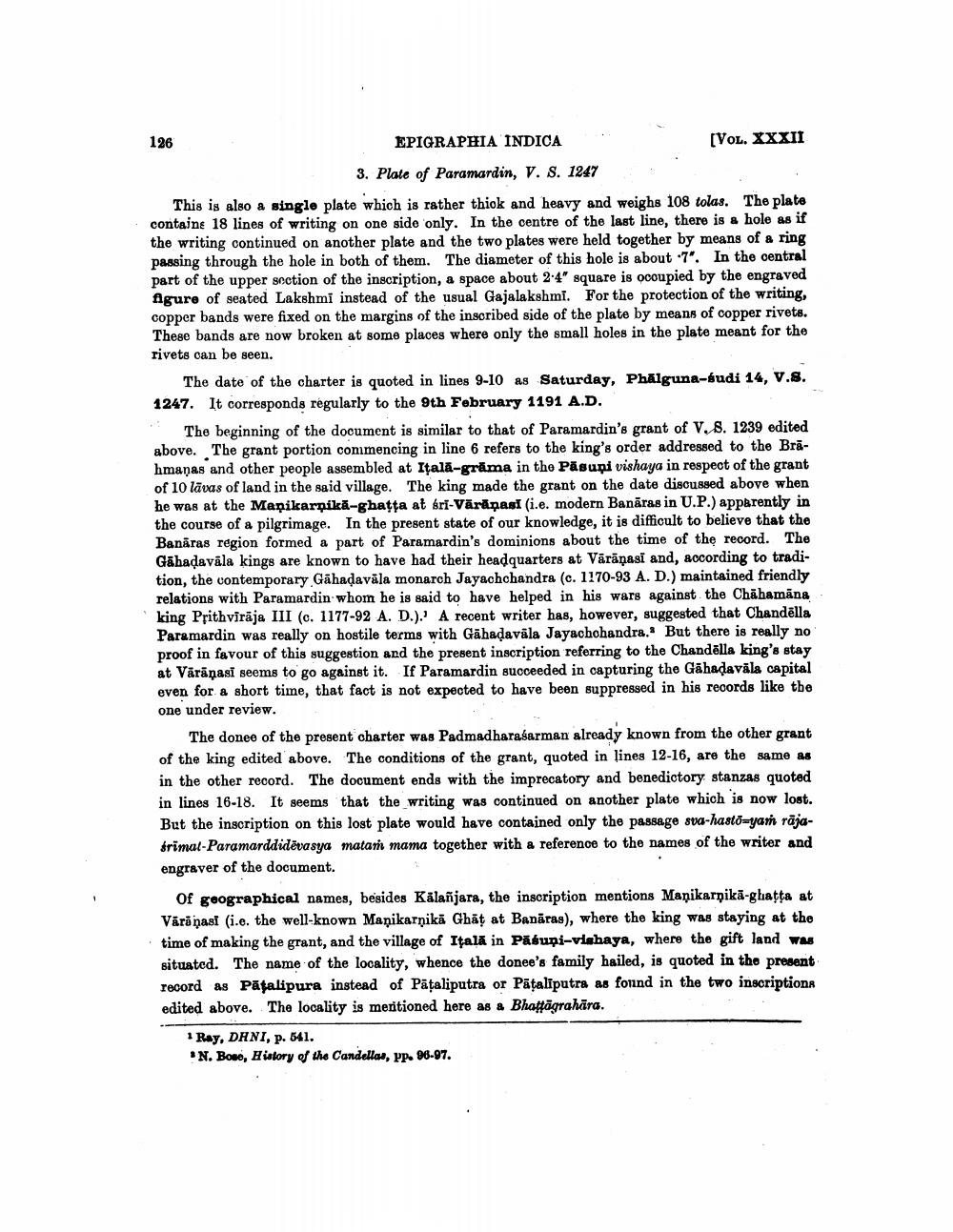________________
126
EPIGRAPHIA INDICA
(VOL. XXXII
3. Plate of Paramardin, V. S. 1247 This is also a single plate which is rather thick and heavy and weighs 108 tolas. The plate containe 18 lines of writing on one side only. In the centre of the last line, there is a hole as if the writing continued on another plate and the two plates were held together by means of a ring passing through the hole in both of them. The diameter of this hole is about 7". In the central part of the upper section of the inscription, a space about 2.4" square is ocoupied by the engraved Agure of seated Lakshmi instead of the usual Gajalakshmi. For the protection of the writing, copper bands were fixed on the margins of the inscribed side of the plate by means of copper rivets. These bands are now broken at some places where only the small holes in the plate meant for the rivets can be seen.
The date of the charter is quoted in lines 9-10 as Saturday, Phålguna-sudi 14, V.8. 1247. It corresponds regularly to the 9th February 1191 A.D.
The beginning of the document is similar to that of Paramardin's grant of V. S. 1239 edited above. The grant portion commencing in line 6 refers to the king's order addressed to the Brāhmanas and other people assembled at Italā-gråma in the Pāsuņi vishaya in respect of the grant of 10 lāvas of land in the said village. The king made the grant on the date discussed above when he was at the Manikarnika-ghatta at sri-Vārānasi (.e. modern Banāras in U.P.) apparently in the course of a pilgrimage. In the present state of our knowledge, it is difficult to believe that the Banaras region formed a part of Paramardin's dominions about the time of the record. The Gāhadavāla kings are known to have had their headquarters at Vārāṇasi and, according to tradition, the contemporary Gahadavāla monarch Jayachchandra (c. 1!70-93 A. D.) maintained friendly relations with Paramardin whom he is said to have helped in his wars against the Chābamäng king Prithvirāja III (c. 1177-92 A. D.). A recent writer has, however, suggested that Chandella Paramardin was really on hostile terms with Gāhadavāla Jayachchandra. But there is really no proof in favour of this suggestion and the present inscription referring to the Chandēlla king's stay at Vārāṇasi seems to go against it. If Paramardin succeeded in capturing the Gähadavāla capital even for & short time, that fact is not expected to have been suppressed in his records like the one under review.
The donee of the present charter was Padmadharaśarman already known from the other grant of the king edited above. The conditions of the grant, quoted in lines 12-16, are the same as in the other record. The document ends with the imprecatory and benedictory stanzas quoted in lines 16-18. It seems that the writing was continued on another plate which is now lost. But the inscription on this lost plate would have contained only the passage sva-hasto=yam rājaSrimat-Paramarddidëva sya matan mama together with a reference to the names of the writer and engraver of the document.
Of geographical names, besides Kālañjara, the inscription mentions Manikarnikā-ghatta at Vārāṇasi (i.e. the well-known Manikarnika Ghāt at Banāras), where the king was staying at the time of making the grant, and the village of Italā in Păsupi-vishaya, where the gift land was situated. The name of the locality, whence the donee's family hailed, is quoted in the present record as Patalipura instead of Pāțaliputra or Pātaliputra as fonnd in the two inscriptions edited above. The locality is meritioned here as a Bhattägrahāra.
1 Ray, DANI, p. 541. 'N. Bove, History of the Candellos, pp. 96-97.




